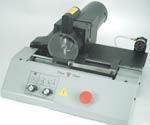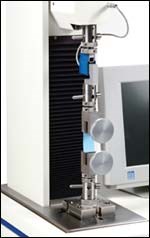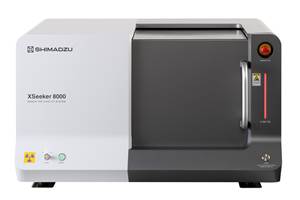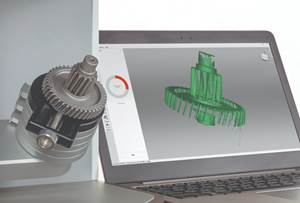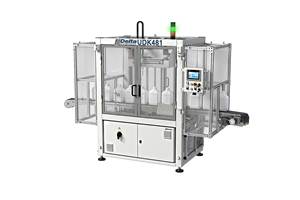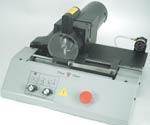How to Buy Universal Testing Machines
More processors today are buyingso-called ‘universal’ testers to measure tensile, flexural, compressive, and shear properties for materials evaluation, application development, and quality control. Advanced electronics have improved these instruments’ performance and ease of use—and even led to lower prices.
Universal testing machines (UTMs) stretch, bend, compress, or pull plastic samples at a controlled speed until they break. They are among the most common instruments found in plastics compounders’ laboratories. They use the UTM during compound development to determine a material’s suitability for a given process and end-use application. The UTM also comes in handy for production quality control to ensure lot-to-lot consistency.
UTMs today are also showing up more frequently in the labs of plastics molders and extruders. One reason is their increased involvement in upfront product and process development. Another is their stricter scrutiny of quality control of both incoming materials and of finished parts.
Says Richard McManuis, product manager for Instron Corp., “Many OEMs, particularly in areas of high liability like medical devices or automotive, require plastics processors to do their own testing at the end of production runs. Another reason for testing in-house is to improve process control, which can reduce scrap rates and result in a real payback.”
Different kinds of tests
A UTM consists of one or two vertical load-bearing columns on which are mounted a fixed horizontal base plate and a moveable horizontal crosshead on top. In today’s UTMs, the columns usually have ball-screw drives to position the moveable crosshead.
The size of a UTM is described by a combination of the maximum load ratings of the frame and of the load cell or sensor that measures the load/force. The load cell is attached to the moving crosshead that is driven by electric motors or hydraulics. A load cell in series with the grip measures the force, which can be read on a digital display or a PC. Many UTMs have interchangeable load cells so that the sensor can be matched to the material being tested.
UTMs apply force to a specimen in order to induce strain in the plastic. The particular test—tensile, flexural, compression, or shear—is classified in terms of the direction in which strain is induced in a specimen and the speed at which the force is applied. Static tests are performed with a standard electromechanical UTM. They generally involve loading the specimen at speeds ranging from 0.001 in. to 20 in./min. Dynamic or cyclic tests such as crack growth and fatigue are typically performed on servo-hydraulic UTMs with lower loadings over long periods of time.
Earlier UTMs had analog electronics and a chart recorder. They have been replaced by digital controls and PC software. The new controls automatically run the test and display the data—sometimes even while the test is going on. In the the old days of chart recorders, and even in the early digital era before PCs, all the user obtained from the test were load/deformation curves representing force on the y-axis versus deformation on the x-axis. These curves required calculation and interpretation. The newest systems still provide these curves, but they also calculate the desired data such as yield and failure strength and modulus.
By far the most common tests performed on plastics with a UTM are tensile strength and modulus and flexural strength and modulus. For tensile testing by ASTM D638 and ISO 527, the sample is clamped at both ends. One clamp is stationary and the other is in a crosshead that moves away from the fixed clamp, pulling on the sample until it breaks, after which the crosshead automatically halts.
Flexural testing (ASTM D790 and D6272 and ISO 178) is performed by placing a specimen on two supports on the stationary bed of the machine. For this test, the crosshead moves in the opposite direction from that of a tensile test, pushing instead of pulling on the unsupported center of the specimen until it bends and possibly breaks. Because many thermoplastics do not break in this test, it may not be possible to calculate the ultimate flexural strength. Instead, the standard test protocol calls for calculating flexural stress at 5% strain.
Less common uses of UTMs are for compression tests, although they play a major role in testing of rigid plastic foams in accordance with ASTM D1621 and ISO 844. UTMs can also be used for crush testing of any type of molded product such as bottles. Compressive strength is calculated as the stress required to rupture the specimen or deform it to a given percentage of its height.
Shear tests are even rarer for plastics, according to suppliers of UTMs. Shear strength is obtained by placing a specimen in a punch-type shear fixture. The punch is pushed down at a rate of 0.005 in./min until the moving portion of the specimen clears the stationary portion. Shear strength is calculated as the force/area sheared. It is important in film and sheet products where failures from this type of load can occur, whereas it is rarely a factor in the design of other extruded and molded products. Plastic sheets or molded plastic discs 0.005 to 0.500 in. thick are used in the test according to ASTM D732 (there is no ISO equivalent).
How a sample is held in the base of the machine is critical, since different types of tests require different grips or fixtures. There are hundreds of types of grips and fixtures of various mechanical designs. They range in cost from a couple of hundred dollars to as much as $4000 to $5000 for hydraulically operated grips.
For tensile testing of plastics, the most common type is the wedge-action, self-tightening grip. It self-tightens as load is increased. For flexural tests, the most common is the three-point bending fixture. Saucer-shaped platens are used for compression testing. For shear tests, fixtures and grips are typically made by the user or custom made by the UTM supplier.
Electromechanical UTMs
The commonly used electromechanical units range in capacity from 100 to 135,000 lb. The larger the size, the higher the cost. Whether single- or dual-column, the most commonly used machines in testing plastics are vertical benchtop units. The same principles apply to horizontal machines, which are primarily relegated to use in automated processes that utilize robots to handle samples continuously. Vertical machines have a smaller footprint and are easier to operate. They have gravity in their favor, which makes them suitable for delicate samples such as films as well as heavier molded parts.
Single-column UTM machines have lower force capacity and lower cost. They come in frame capacities up to 1000 lb. Dual-column UTMs are available in load-frame capacities from 1000 to 135,000 lb. Load cells are also rated for a certain maximum force that should be appropriate for the UTM frame and the sample. For example, a 100-lb load cell placed in a 1000-lb frame allows testing with up to 100 lb of force. Capacity of the load cell should not exceed by too large a margin the estimated breaking load on the sample or measurement accuracy will suffer.
Many plastics users do well with single- or dual-column units with up to 5000-lb capacity and a set of three load cells, according to Wayne Hayward, Tinius Olsen’s marketing manager. His firm’s most popular UTMs have 1000- and 2000-lb capacity.
Craig Stanton, marketing manager at MTS Systems, agrees that machines most commonly used in plastics testing are within the 2000- to 5000-lb frame-capacity range.
MacManuis from Instron says testing of unreinforced plastics rarely uses more than 2000-lb frame capacity. For filled and reinforced plastics, machines with frame capacities of 5000 to 7000 lb are often needed. But for composites with continuous glass, carbon, or other fibers, load frames of up to 60,000-lb capacity or more may be required.
If you buy a machine with much more capacity than you need, you will not only pay more in cash, but you will also pay in testing time. Larger units run more slowly. For example, a machine with a 250-lb frame commonly runs at up to 40 in./min, and a 5000-lb frame runs at up to 20 in./min.
Single or dual column?
How much maximum load you will typically need depends on the type of materials you are testing and is among the key issues to consider in deciding whether to opt for a single-column or a dual-column machine. Also consider whether you will require a large environmental chamber for testing at controlled temperatures. Dual-column units are taller and allow for larger samples and larger thermal cabinets to be inserted between the columns. If you will be doing any compression testing of foams, a dual-column unit is typically required because the samples tend to be large.
Dual-column machines are also stiffer by nature. As a result, there is less deflection during testing. Last, but not least, is the cost difference. Single-column UTMs can be had for as little as $7000 to $10,000, while dual-column models are generally priced in the $13,500 to $30,000 range. These price ranges are just for the machine. Prices for load cells can range from $1500 to $5000. Data-acquisition and analysis software, not including a PC, can run upwards of $2500. Grips and fixtures are another separate cost, as are installation and training. If you need one, thermal chambers typically sell for $8000 to $20,000.
Software advances
Mechanical and electronic design of UTMs is fairly mature. The new developments are in control software. Modern PC software provides increased productivity and accuracy and is easier to use. Says Instron’s McManuis, “The software capabilities add a level of reproducibility not previously attained.”
Adds Art Nehr, marketing manager at Testing Machines Inc., “Rather than rely on a single reading at the breaking point, designers and quality managers now can see what happens throughout a test. Did the material stretch or deform before breaking? Did it deform in proportion to the force? The answers can help them evaluate alternative materials, determine safety margins, and better simulate end-user applications.”
The new software automates testing, data collection, analysis, report output, and data storage and retrieval. A user can tell the machine to run at a certain load rate and the system will automatically adjust the speed of the crosshead. New software also allows users to get true strain values during tests by means of position transducers that measure exactly how far the crosshead has moved. The change in length of the specimen is divided by its original length to give automatic strain calculations.
New software also allows for automatic load-cell identification and calibration when changing transducers. It “reads” the electronics of the load cells and sets up the parameters, eliminating the mechanical modifications previously performed by an operator.
Newer software with faster data acquisition provides more accurate capture of peak loads and allows more detailed examination of stress/strain curves when running tests at higher speeds or with fluctuating loads. Typical data-acquisition rates are around 50 Hz (taking readings 50 times per second), though sampling rates up to 5 kHz are available.
The newest PC-driven UTMs are less expensive than machines with digital control panels that have been around for more than a decade. New PC models have simpler controls and often do away with the digital display that provides the graphical readout. Says Hayward from Tinius Olsen, “The software of new PC-based UTMs now drives the whole operation, so that the cost can be knocked down by eliminating the digital display and some electronics.”
Last year, Tinius Olsen launched the PC-based T-Series of single- and dual-column UTMs with capacities up to 22,250 lb. Hayward estimates that the machines in the T-Series, including the PC and Test Navigator software for data acquisition, cost about 10% less than the company’s S-Series of benchtop units, which have a digital control panel. Says Hayward, “The user has to reprogram an S-Series machine to change the test routine. With the PC-driven T-Series, you can have a choice of user-selectable test routines that measure different parameters.”
Instron recently increased the range of options for its new Model 3300 series of cost-effective, PC-driven single- and dual-column UTMs with frame capacities up to 11,000 lb. According to McManuis, design changes in both the frame and the electronics have reduced the cost of these units. The 3300 series has no hardware control panel, but uses dedicated electronics in the load frame for measurement and control. Instron’s other two series of electromechanical UTMs—the higher-performance Models 5500 and 5800 with frame capacities of 100 to 135,000 lb—are also PC-driven but use hardware control panels in addition to the measurement and control electronics in the frame, although with fewer buttons than earlier versions.
A fully equipped, single-column, 1000-lb unit in these three series ranges from $19,000 to $30,000. Fully loaded dual-column models of 1000 to 5000 lb cost $19,000 to $36,000. Included in the price are the PC, Series IX/s software, one set of grips, and one load cell.
Dual-column units of 2000- to 5000-lb frame capacity in MTS Systems’s new PC-based Alliance RT tabletop series cost $25,000 to $50,000. This includes the machine, a PC, TestWorks 4 software, one load cell, a set of grips, installation, and training.
The RT series’ digital control system comes on a single circuit card in the load frame. It is said to increase reliability and reduce downtime. The exclusive six-point guidance system is said to provide superb crosshead guidance through the x, y, and z axes for improved accuracy and repeatability.
Also relatively new from MTS is the Synergie Low Force series of UTMs. These are single-column tabletop units of up to 1000-lb frame capacity. Also PC-based, they are said to be popular for thin-film testing.
Testing Machines, Inc., recently introduced the LabMaster single-column UTM system for low-force testing at up to 250 lb. This R&D instrument combines the tensile tester, load cell, and network-ready Windows PC in a single case with a flat-panel, touchscreen display to minimize bench-space requirements. It includes the newest enhancement to the company’s LabMaster software, called the Test Method Wizard, which simplifies set-up and automates the test sequence. It boasts high resolution to detect minute changes in load or sample position. It sells for $16,000 to $16,500.
Applied Test Systems recently introduced the upgraded ATS 1600 Series, which now consists of dual-column units in load-frame capacities from 1000 to 500,000 lb. They are PC-driven with the company’s TestVu software. Marketing manager Denny King says Models 1601 to 1605 (1000- to 5000-lb capacity) cost $20,000 to $25,000 and include the PC, software, and a load cell, but no fixtures.
Ametek Inc.’s Test and Calibration Instruments Div. has introduced two newly enhanced, single-column UTMs from its Lloyd Instruments subsidiary in the U.K. They have a wider range of crosshead speeds than earlier versions, plus improved electronics and increased speed of communications via the company’s proprietary Windows PC-based Nexygen materials-analysis and testing software. Their integral control console has a keypad and LCD display.
One version is the LFPlus Series digital testing machine, a low-force unit for loads up to 250 lb. It has a speed range of 0.002 to 50 in./min and improved electronics that reportedly increase the data-sampling rate of the machine eight-fold. The other version is the LRXPlus series with capacities of up to 1100 lb and crosshead speeds of 0.004 in. to 49 in./min. It can store up to 600 test results from a choice of 10 programmable test set-ups.
Affordable dynamic tests
Unlike electromechanical UTMs that perform static tests, servo-hydraulic UTMs perform dynamic or fatigue tests. These entail applying force over and over in a cyclic load-and-release action. For example, in fatigue crack-growth tests, a user is looking to determine how many cycles it takes for the material to break. Dynamic tests require less force than static tests on electromechanical machines.
Servo-hydraulic machines come in load capacities ranging from 100 lb into the tons and typically sell for two to three times the cost of electromechanical UTMs. They have been used primarily for fatigue testing of metals, but are getting increasing play in plastics for automotive, aerospace, biomedical, and electronics applications where plastics have been replacing metal in structural parts subject to fatigue. “We have been seeing processors asked to test plastic components to provide information on their life cycle,” says Stanton from MTS, a leader in servo-hydraulic machines.
In the last two years, MTS has developed two PC-driven servo-electric, single-column UTMs that reportedly have unique capabilities for performing a range of low-force dynamic and static tests on materials and small components. Although not low-cost, these units make dynamic testing more affordable than ever before. The benefit of servo-electric over servo-hydraulic drive is avoiding the need for hydraulic oil, a pump, and water cooling.
The first servo-electric models on the market were specialized units of very low force capacity. One is the MTS Tytron 250 MicroForce, a 50-lb horizontal-frame unit that has been used to test thin packaging films, biomedical tubing and sutures, and micro-electronics. Another MTS model, the NanoBionix, is geared primarily to biomaterials research and product development. It has speeds of up to 2500 cycles/sec with a maximum load of only 51 g. It is suited for testing both quasi-static and dynamic properties of viscoelastic materials or very small microelectronic components.
Now MTS has just come out with the first servo-electric UTM with higher frame capacity—1000 lb. This brand-new PC-driven, dual-column unit performs standard static tests and dynamic testing at up to 20 Hz. Says Stanton, “This is a breakthrough in servo-electric frame capacity and it provides plastics processors a machine that can do dynamic testing without the considerable cost of a servo-hydraulic unit.” The new Evolution UTM will debut at NPE in June and will sell for around $50,000 as a complete system—in the same range as a higher-end electromechanical system or a lower-end servo-hydraulic model.
Related Content
X-Ray Vision Inside Parts Gets More Affordable for Processors
Shimadzu’s new benchtop x-ray CT scanner provides internal and external metrology and flaw detection at a fraction of the previous cost.
Read MoreNext-Generation Industrial Desktop 3D Scanner for QC
Exact Metrology’s newest version of Artec Micro boasts ultra-high precision.
Read MoreK 2022: ‘All-in-One’ Bottle Tester Takes Three Measurements at Once
Delta Engineering’s new system performs simultaneous topload, height and both pressure-decay and high-voltage leak testing.
Read MoreTracing the History of Polymeric Materials -- Part 30: Polyurethane
In the world of polymers, polyurethane chemistry is probably the most versatile. This a resulted in a wide range of products made from these materials and given the industry the flexibility to respond to the progressive march of regulatory concerns.
Read MoreRead Next
IMPACT: Which Test to Use? Which Instrument to Buy?
Impact testing is a complex and controversial subject, and one that is in the midst of change. These factors add challenge to selection of the most appropriate impact instrument for a processor's lab.
Read MoreTroubleshooting Screw and Barrel Wear in Extrusion
Extruder screws and barrels will wear over time. If you are seeing a reduction in specific rate and higher discharge temperatures, wear is the likely culprit.
Read More

